By Sofia Santos with contributions from Mirte den Braber and Guy Agam Fusfus
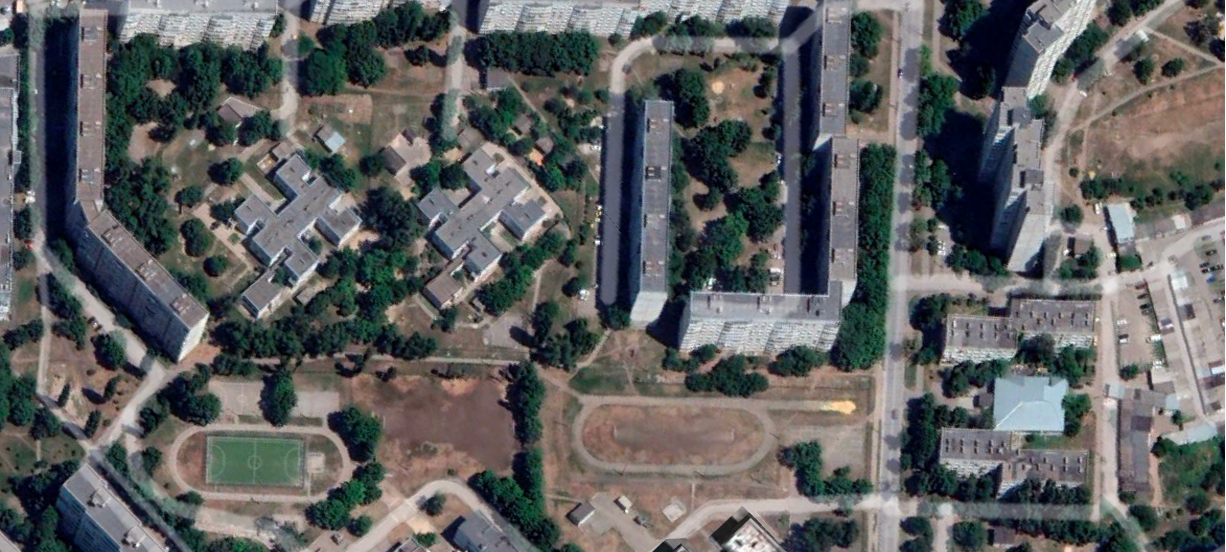
For the past six months, Kharkiv has been under almost permanent Russian shelling. Between February and July 2022, Eyes on Russia (EoR) verified hundreds of data submissions to our database documenting the partial or complete destruction of civilian infrastructure at the hands of the Russian military in the city of Kharkiv. Out of those verified, 41 entries detail the shelling of educational institutions.
Analysis of the areas surrounding affected educational facilities suggests the shelling was targeted, rather than a by-product of indiscriminate attacks on civilian infrastructure.
It was possible to establish a likely firing range angle from which the Russian military was discharging the munitions during the month of June. This was done by analysing the shelling damage and the impact points where the projectiles hit the targeted schools.
As well as structural damage, there is evidence to suggest that targeted shelling of educational facilities in Kharkiv caused:
The partial or complete destruction of lecture halls and athletic training facilities,
Damage to university laboratories and libraries containing ancient books,
Destruction of pre-school playgrounds,
Damage to specialised equipment for children with disabilities.
With the new academic year beginning on September 1, 2022, there is a legitimate risk that the majority of schools in Kharkiv will be unable to open due to either safety concerns, or the destruction of infrastructure. However, as the war shows no signs of slowing down, the situation could get even worse.
PLEASE NOTE:
This report contains descriptions of graphic imagery/violence that some readers may find distressing. Additionally, where graphic footage has been EOR investigators it is linked in the footnotes with the explicit warning of “graphic footage.”
Introduction
On February 25, 2022, Dr. Sergey Skarlet – the Ukrainian Minister of Education and Science – shared a letter on the Ukrainian Ministry of Education and Science’s website, and his official Telegram channel. The letter, which was sent to all heads of educational facilities, requested that lessons be halted and announced the temporary interruption of the school year for two weeks.
On the same day, Eyes on Russia (EoR) recorded the first of many shelled educational facilities in Kharkiv. Six months later, and with the start of the new academic drawing nearer (September 1st, 2022), dozens of educational facilities have either been partially or completely destroyed within the city of Kharkiv.
The structural damage suffered at the hands of the Russian forces is not the only problem facing an entire generation of students. Educational institutions are part of a wide ecosystem that provide a learning environment for students of any age, ability, and aspiration.
Among the educational facilities targeted and shelled by the Russian military in Kharkiv were a boarding school for visually impaired students, a 218-year old university library, a university training pool used by olympic athletes, and an almost 100-year old vocational college. The shelling did not just destroy classrooms, it blocked the safe access to specialised equipment for children with disabilities, endangered books that had previously survived World War II, sabotaged Olympic dreams, and interrupted teaching at colleges that have been operational for generations.
The people of Kharkiv will be forced to start the new academic year in a city under continued shelling.
Shelling of Educational Facilities in Ukraine
The official Ukrainian Prosecutor General’s Office’s Telegram channel has been publishing a small daily report on the effects of the war on children and their access to education since March 13.
On July 31, the channel reported that 2,199 educational institutions in Ukraine were damaged as a result of bombing and shelling, and out of those, 225 were completely destroyed. The report added that, since the beginning of the Russian invasion, 358 children had died as a result of the armed aggression against Ukrainian civilians, and over 1,051 minors were injured. Out of those numbers, 195 were specific to Kharkiv.
On July 26, the Kharkiv City Council Telegram Page published the minutes of a meeting attended by the Kharkiv’s Mayor, Igor Terekhov, that took place earlier that day. According to the notes, Mr. Terekhov pointed out that Kharkiv had only been spared from heavy shelling for five days out of the 153 days of war. Since the war began, the Russian forces “destroyed thousands of multi-story buildings, hundreds of administrative buildings, including kindergartens, medical institutions, and more than half of schools”.
Prior to this, on July 13, Dr. Skarlet, attended a televised fundraising event in Kharkiv where, according to a “Kharkiv Today” news article, he announced that, in Kharkiv, “out of 24 institutions of higher education, 21 are damaged.” He then added that at “kindergartens, schools, vocational training institutes, colleges — not a single object at all escaped the blows of enemy aggression.”
Verified shelling of Educational Facilities in Kharkiv
Between February and July 2022, EoR recorded 41 separate instances of the shelling of educational facilities in the city of Kharkiv. The graph below illustrates the number of damaged or destroyed educational facilities per month, due to Russian bombing.
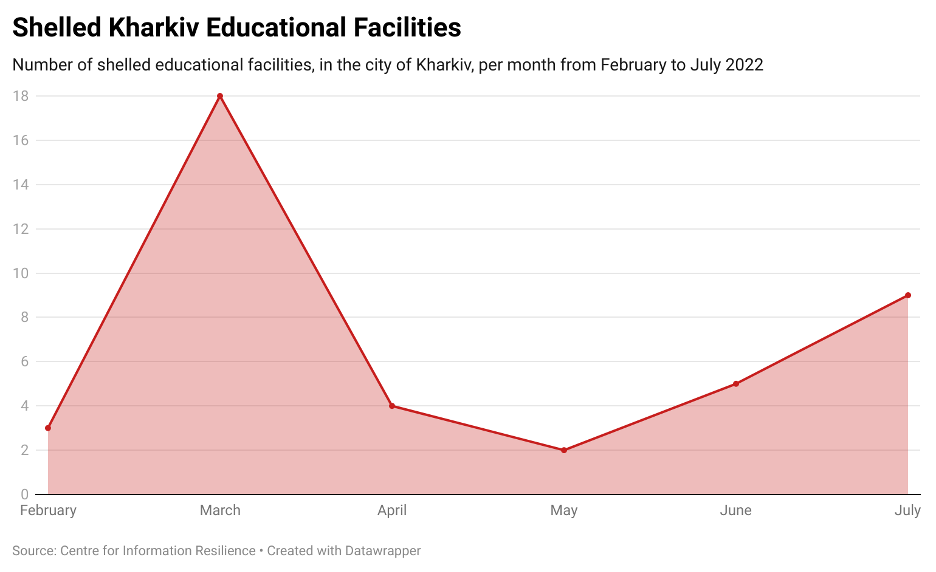
Figure 1: A graph showing the number of shelled educational facilities in Kharkiv per month.
In terms of the type of educational facility targeted by the Russian military, EoR verified the partial or complete destruction of five different types of institutions due to shelling between February and July 2022.
Among the affected educational buildings, there were pre-schools, comprehensive schools, specialised schools, vocational colleges, and universities – some of which were targeted on more than one occasion.
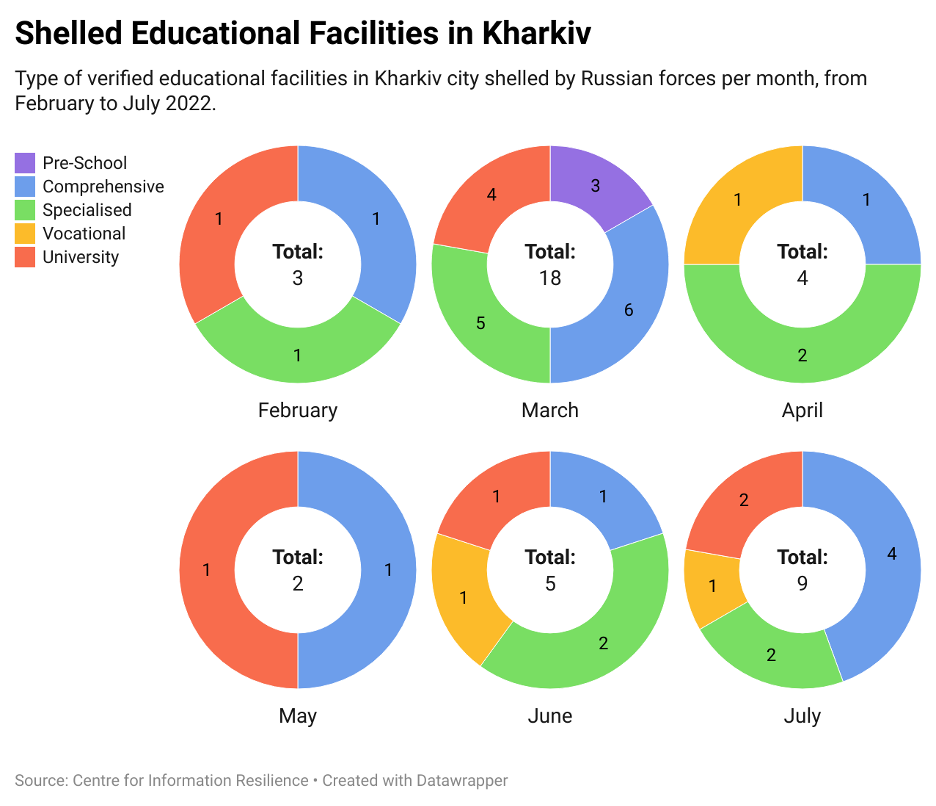
Figure 2: The type of educational facilities hit in Kharkiv
Although the month of March displays by far the highest number, with 18 verified cases of shelling of educational facilities in Kharkiv, it is also possible to observe a clear uphill trend from June onwards.
With August being the last official month of the school holidays in Ukraine, there is a real danger that Kharkiv will be unable to provide a safe educational environment for children on September 1. Many of the shelled institutions, some of which have been targeted more than once, may not be standing when September comes.
The direct targeting of educational facilities by the Russian military
The official Telegram channel for the Ukrainian Security Service published a message on August 21, claiming that, over the past six months of war, the Russian military has systematically targeted civilian infrastructure. They claimed that only 1 out of 20 missile strikes hit military targets. According to the Ukrainian Security Service, the “remaining 19 [missiles] hit residential buildings, schools, hospitals, universities”.
Between February and July 2022, EoR recorded, geolocated, and verified, a total of 411 user generated verified entries in the EoR database of shelled civilian infrastructure in the city of Kharkiv.
These database entries, which include healthcare, commercial, religious and educational facilities, were all mapped below to provide a visualisation of the impact that the first 157 days of war had on the city of Kharkiv.
Each red dot represents a shelling target within a 10 metre radius of the nearest verified coordinate.
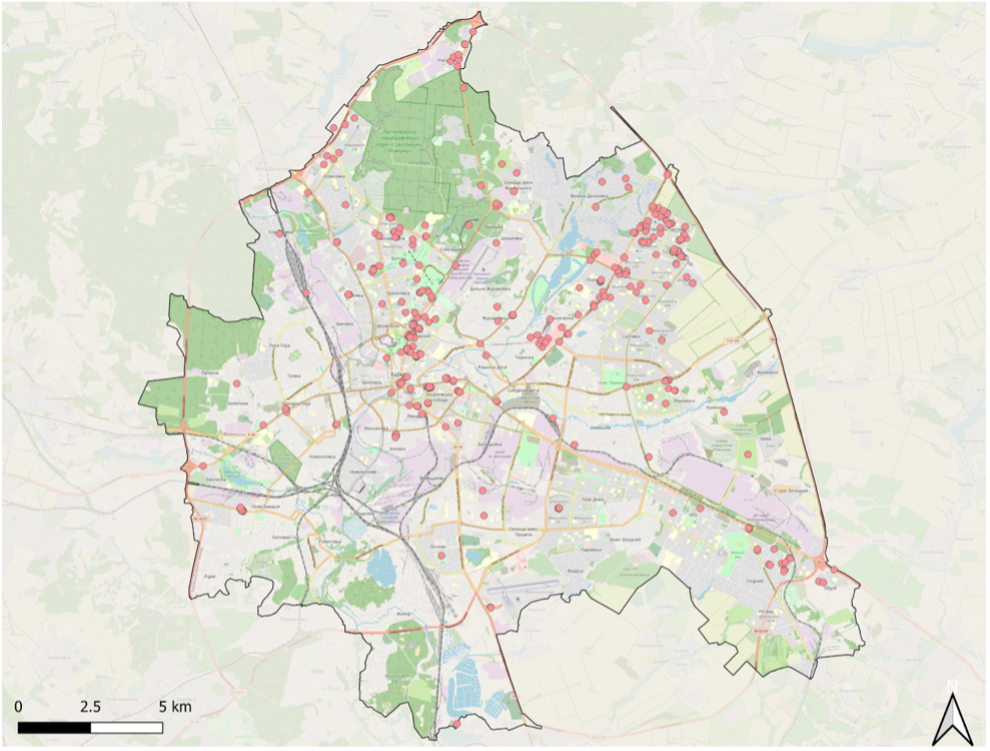
Figure 3: Map showing the location of the verified and geolocated entries of civilian infrastructure damage, in Kharkiv, by Russian shelling between February and July 2022, in the EoR database.
EoR investigators isolated the data entries related to educational facilities and created the map below. It showcases the verified location of all the shelled schools, colleges, institutes, and universities in Kharkiv, from February to July 2022.
It is important to note that the colour of the pinpoints on the map below show only the month of the most recent attack as some locations were hit twice. For example, the legend states that in June there were five educational facilities in Kharkiv shelled by the Russian forces, however only four orange pinpoints can be seen on the map. This is due to the fact that one of the buildings was targeted both in June and in July; therefore it appears as red on the map.
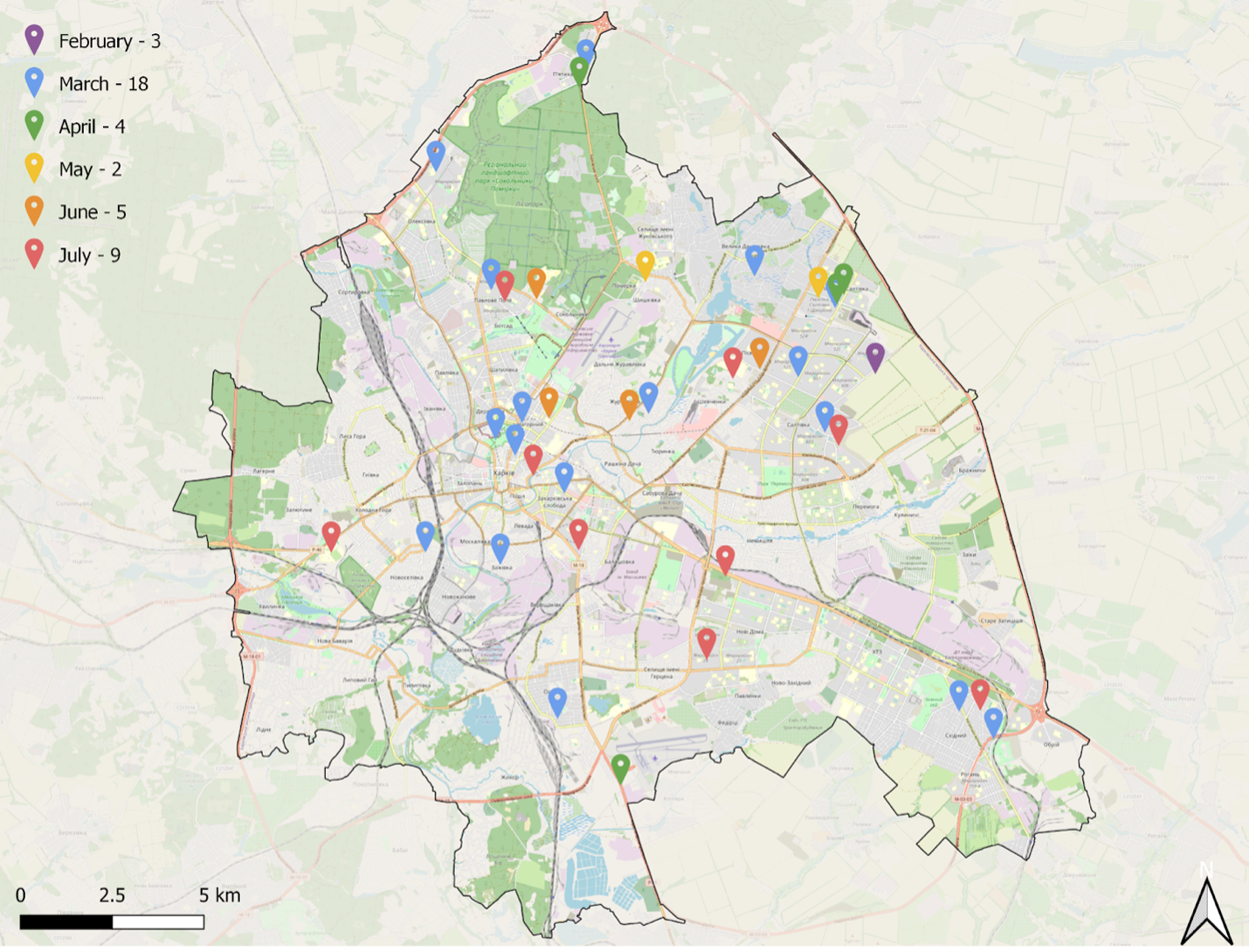
Figure 4: Map showing the location of the verified and geolocated entries of infrastructure damage to educational facilities in Kharkiv, by Russian shelling, between February and July 2022, in the EoR database.
A few conclusions can be drawn from a comparison of these two maps.
Although some districts have clearly been targeted more than others, it is observable that, in some areas, the only target within a wide radius was a school; this was more prevalent in the Southern area of Kharkiv.
The data provides some evidence to corroborate the claim that the Russian forces were directly targeting educational facilities in the area as opposed to carrying out indiscriminate shelling of the city.
The maps below provide a comparison between the location of shelled educational facilities (left) and the overall picture of shelled civilian infrastructure in Kharkiv (right). The square boxes indicate the area within which nothing was shelled apart from educational facilities. As can be seen, there were many instances in which the educational facility was the only building shelled within a radius of 1.5km to 3km.
It therefore appears highly likely that the educational facilities were the target of the shelling, as opposed to collateral damage.

Figure 5: Maps highlighting the targeting of educational facilities (left) in comparison with overall infrastructure damage in the same area (right) caused by Russian shelling between February and July 2022.
Overall, there is evidence to suggest that the Russian military was heavily shelling civilian infrastructures in Kharkiv. There are also clear signs of the direct targeting of educational facilities, predominantly in the Southern districts of the city where the targets were located in areas with a lower density of verified and geolocated shelling damage.
Possible firing positions
Whilst observing the density of the civilian infrastructure damage, caused by Russian shelling in the city of Kharkiv between February and July 2022, it is possible to discern a clear area of interest.
This data, as seen below, provides some insight on the possible firing positions of the Russian forces.
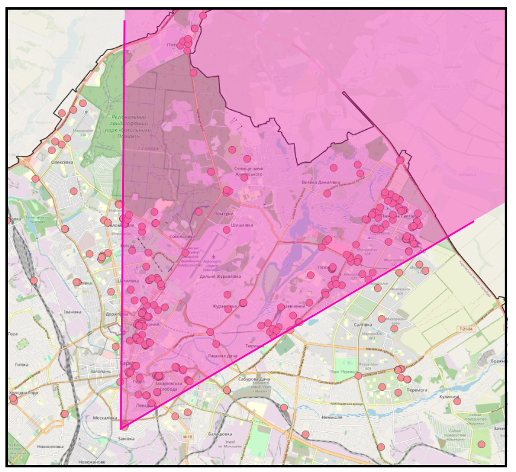
Figure 6: Map showing the area in the north of Kharkiv in which a higher density of shelling was verified and geolocated , between February and July 2022.
As previously seen, March was by far the worst month in terms of the total number of educational buildings shelled in Kharkiv.
Although there was a significant decline in April and May, the numbers increased again in June and July. Whilst attempting to establish the firing range of the most recent escalation of Russian aggression against educational facilities in Kharkiv, EoR investigators looked at the infrastructure damage visible and the crater location on/near the buildings shelled in June 2022.
Although there were five different educational facilities shelled in June, one of them had previously been targeted in March, therefore was removed from the pool of data to avoid inaccurate conclusions. The main structural damage and crater locations for the four remaining buildings and school grounds were analysed and mapped.
The areas affected are highlighted in purple in the images below.
The top left shows the mapped damage on the “Housing and Communal College of KhNUMG”.
The top right shows damage to the “Sports Complex Polytechnic”. The bottom left shows the location of damage to the “Specialised School №29” property, and the bottom right shows the location of damage to the “Secondary School of I-III Grades №78”.
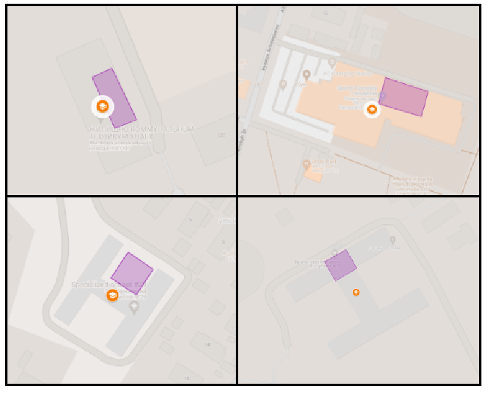
Figure: Image showing the location of the missile impact and surrounding damage on four educational facilities in Kharkiv, in June 2022. All images are facing North.
By analysing the surrounding buildings it is possible to verify the direction the missile travelled. If the projectile had been fired from a different angle, it would have damaged different walls which were, as seen on online footage and photos, still standing.
The figure below shows the possible angles from which the projectile arrived at the educational buildings, shelled in June 2022.
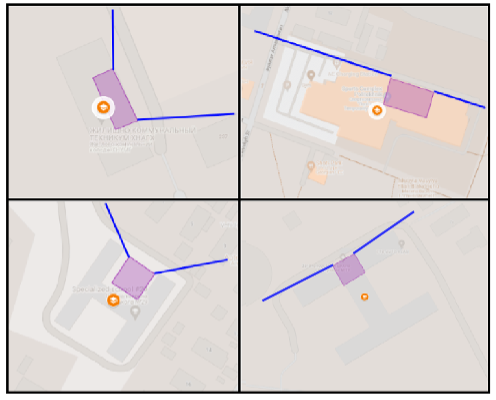
Figure: Image showing the possible angles of the missile arrival on four educational facilities in Kharkiv, in June 2022. All images are facing North.
By collating all four images together and lining up both the most Western impact angle and the most Eastern impact angle, EoR investigators were able to narrow down the possible firing locations.
The image below provides a visual explanation of the process described above. The first image, on the left, contains the four initial images lined up on the most Western impact angle (pink circle), the middle image contains the images lined up on the most Eastern angle, and the last image is the compilation of the data gathered from the first two images.

Figure 9: Analysis of the possible angle of the missile arrival on the educational facilities in Kharkiv, targeted in June 2022. All images are facing North.
When these possible firing angles are compared with the possible firing angles inferred from the overall shelling of civilian infrastructure between February and July 2022 (as seen earlier in the report) similarities become evident.
Below on the left is the Kharkiv map showing the most densely targeted area between February and July 2022 highlighted in pink. The right shows the angles obtained from observing the crater location and nearby damaged, or undamaged, buildings shelled in June 2022.
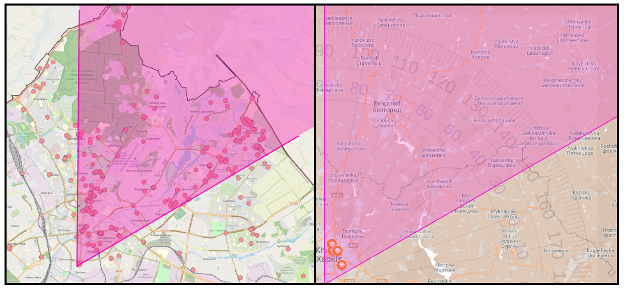
Figure 10: Comparison of the map on the left showing the highest density area of civilian infrastructure damage due to Russian shelling from February to July 2022, and the analysis of the possible firing angle of the projectiles that targeted educational facilities in Kharkiv in June 2022.
The Centre for Information Resilience’s Russia-Ukraine monitor map provides data on Russian firing positions. All the dark dots on the map signal verified and geolocated footage and photos gathered between February and July 2022 which feature Russian military vehicles equipped with projectiles that are positioned towards the Ukrainian border.
Below is a map showing that the geolocated Russian firing positions fall within the possible firing angle range established through EoR’s analysis of civilian infrastructure damage.
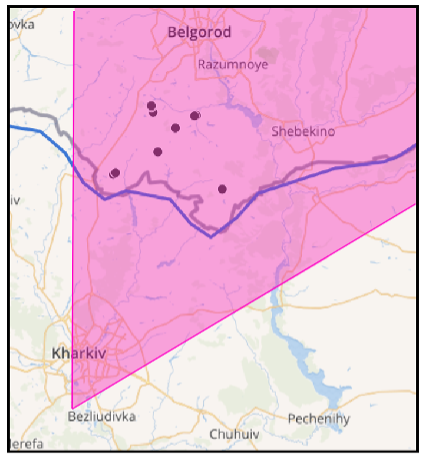
Figure 11: Map showing the verified and geolocated location of the Russian firing positions between February and July 2022, and the possible firing angle previously established through civilian infrastructure damage analysis.
A CNN report in collaboration with the Centre for Information Resilience, analysed projectile flight trajectories targeting civilian infrastructure in Kharkiv in late February.
Using open source data, a number of firing sites within the Belgorod region in Russia were identified, which allowed investigators to determine the specific artillery brigade responsible for the attacks on civilian property.
Although it is not currently possible to establish from which of the locations geolocated on the monitor map the Russian military fired the projectiles towards educational facilities in Kharkiv, this information corroborates previous analyses and builds upon the mounting evidence that the missiles came from the Belgorod region of Russia, close to the Ukrainian border.
Shelling of the different types of Educational Facilities
Between February and July 2022, EoR recorded a total of 41 instances of shelling targeting educational institutions in the city of Kharkiv, causing either a partial or complete destruction of a variety of different types of facilities.
The list included pre-schools, comprehensive schools, specialised schools, vocational colleges, and universities, some of which were targeted more than once. Each of the damaged institutions suffered differently from the ongoing Russian shelling.
The intensity and the location of the damage in and around the properties will undeniably impact the ability of the educational facilities to provide future care and education to a variety of students from a wide range of ages, capabilities, and dreams.
Shelling Damage to Pre-Schools
In March 2022, EoR recorded and verified the shelling of three pre-schools in the city of Kharkiv, all within the same week. These three educational facilities, which until the end of February were providing care and educational content to children up to the age of 7 years old, were all located in the Northern part of Kharkiv, and suffered significant damage to both their buildings and playgrounds.
The photos below present evidence of the damage, caused by the Russian military forces, inside the Pre-School №33 (left), the playground of Pre-School №109 (top right), and the school building of Pre-School №354 (bottom right). Pre-School №33 was targeted on March 17, and Pre-Schools №109, and Pre-School №354 were both shelled on March 22.
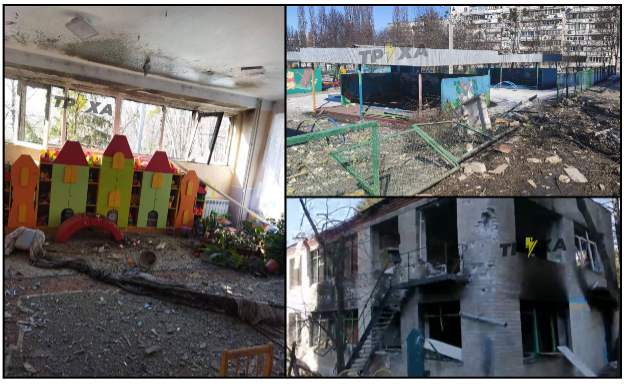
Figure 12: Images of the three shelled pre-schools in Kharkiv in the month of March.
All shelled pre-school institutions were empty after February 25, including at the time of the shelling, as per the order from the Ministry of Education and Science of Ukraine. As a result, no casualties were recorded as a result of the attack.
There was, however, considerable infrastructure damage caused by the Russian shelling as well as subsequent fires, on both the inside of the educational buildings and the surrounding structures and playgrounds.
Shelling Damage to Comprehensive Schools
In addition to pre-schools, many other educational institutions were targeted by the invading forces.
Comprehensive schools, which take in pupils from primary school to the end of their secondary education, were equally targeted. Between February and July 2022 EoR geolocated and verified the shelling of 14 different schools within the borders of the city of Kharkiv.
Among them, at least one, “General education school of I-III degrees №78”, was targeted twice, first on the evening of June 28, and a second time less than two weeks later, on July 11. After the school was hit a second time, on July 11, new extensive damage was observed.
The figure below illustrates the damage to the school after the first strike in June, highlighted in dark blue, and the complete destruction on one of the wings of the building after the July shelling, highlighted in red.
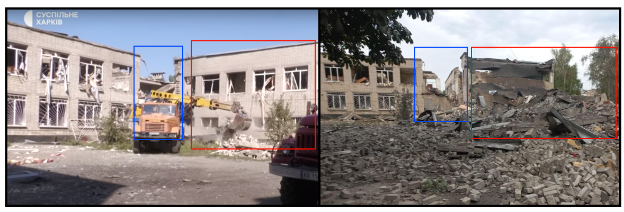
Figure 13: Comparison between the damage to the Kharkiv School № 78 after Russian shelling in June (left) to July (right) [49.950530, 36.307964].
Although a different comprehensive school, the “Kharkiv Gymnasium №46”, was only shelled once, it still suffered significant damage, both outside and inside the property. Suspline Media, the Ukrainian public broadcaster news, published an article on July 10 containing photos and a video of the school following an airstrike at around 3:30am.
Below are some of the images showing the structural damage suffered by the educational institution after being shelled.
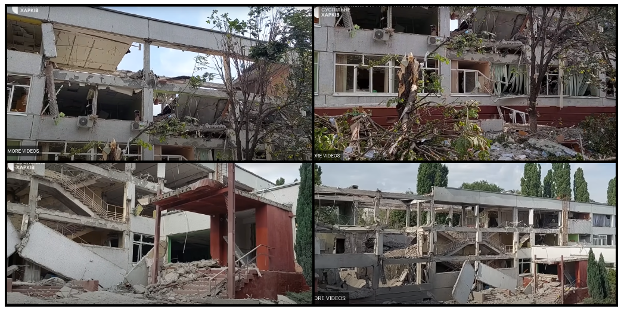
Figure 14: Damage on the outside of the Kharkiv Gymnasium № 46 school [49.977181, 36.259378].
According to Iryna Chepiga, the school’s acting director, “almost all classes are destroyed”. Thus, the 1,580 children that used to attend the school before the invasion have now been deprived of an educational institution.
Below are several screenshots taken from the video which highlight the destruction inside the school. Since late February, including at the time of the attack the school was empty of students.
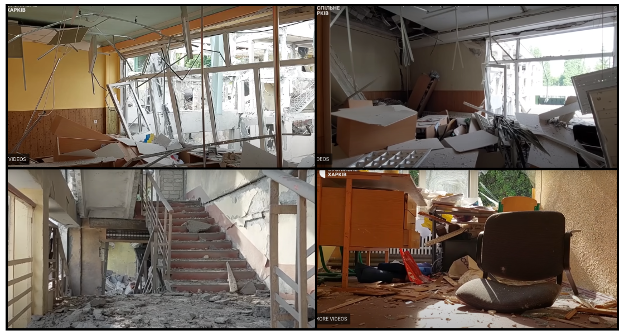
Figure 15: Damage on the inside of the Kharkiv Gymnasium №46 school as a result of Russian shelling on July 10 [49.977181, 36.259378].
Shelling Damage to Specialised Schools
Between the months of February and July 2022 EoR recorded and verified the shelling of 10 different specialised schools within the city of Kharkiv, two of which were targeted twice.
These schools, which catered to children with specific educational needs, suffered considerable damage from the attacks, both to their main buildings but also to the properties’ grounds.
Among one of the shelled specialised institutions was a boarding school for visually impaired children located in the Nemyshlyanskyi District, shelled on June 7. Two projectiles, launched by Russian forces, struck the children’s playground at around 1:20am, producing a sizeable crater in the premises of the institution.
Below is the geolocation of the crater caused by one of the two missiles.
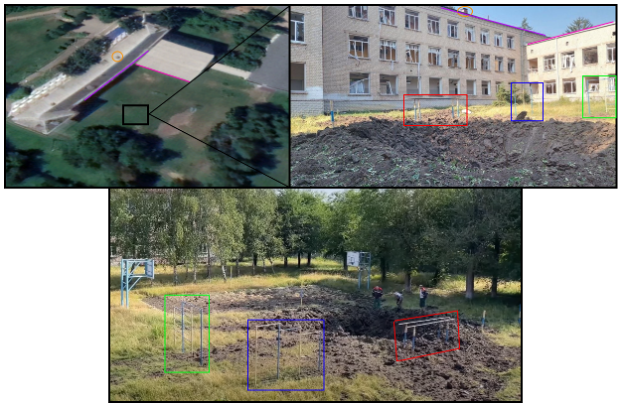
Figure 16: Geolocation of one of the missile craters at the Special Boarding School for Visually Impaired Children № 12, in Kharkiv [49.970468, 36.315681].
The impact caused by the two projectiles and documented by Kharkiv Police Officers, shattered the windows and created a wave of destruction inside the educational facility.
Suspline Media and Kharkiv News, both Ukrainian news broadcasters, shared videos on their respective YouTube channels showcasing the damage, on both the outside and the inside of the school for visually impared children.
Below are several screenshots from one of the videos documenting the destruction caused by the Russian shelling on June 7.
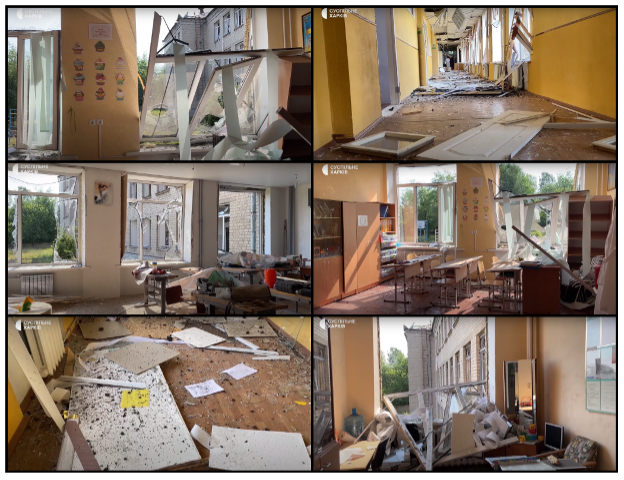
Figure 17: Images showing the destruction inside the school building caused by the shelling on July 7 [49.970743, 36.314962].
In addition to the widespread destruction within the school facilities seen in the images above, the shelling also caused damage to rooms where a variety of fragile tools and specialised equipment were kept.
EoR found an image online of the room where optometric devices and other equipment had been stored before the airstrike (top left image below). This enabled EoR investigators to compare before and after images of the room which was damaged by the Russian shelling on July 7 (top right, bottom left and bottom right images below).
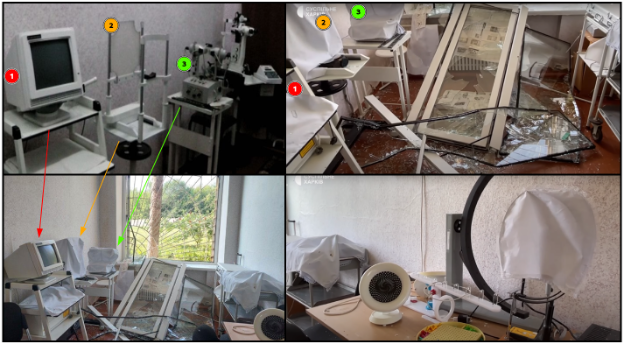
Figure 18: Comparison between the room storing specialised equipment for the visually impaired students before the invasion (top left) versus the same room after shelling on July 7.
The targeting of this Kharkiv boarding school for visually impaired children by the Russian forces has not only caused structural damage to the facilities but also impacted the students’ futures.
The access to specialised educational and medical care that is not easily available in regular schools is in jeopardy, limiting the prospects of these students and their educational future.
Halyna Kuklina, the director of this educational facility that housed 260 children in February, gave an interview to EdCamp Ukraine, an NGO providing an online platform for school teachers in Ukraine.
In the article, published on June 9 and updated on June 15, Ms Kuklina explains how on March 1 they were forced to evacuate the children in their care whilst under Russian shelling.
She explains how, at the beginning of the invasion, the boarding school still housed civilians; however this changed when the school lost heating and electricity. The school’s inhabitants were forced to move to the basement and the children started getting sick.
Ms Kuklina and other colleagues in Kharkiv told EdCamp Ukraine that they regularly visited the subway and bomb shelters to deliver lessons to the children, both those who were visually impared and unimpaired.
Their work has ensured that children taking refuge in the underground still have access to some form of education and normality, while living in a city under constant shelling.
Shelling Damage to Vocational Colleges
Between February and July 2022, EoR recorded and verified the shelling of three vocational colleges in Kharkiv. Among them was the Housing and Communal Vocational College of Kharkiv, an institution first opened for students almost 100 years ago.
In 1928 the college first opened its doors to horticulture pupils, and by 2022 it was providing vocational training to students in a variety of specialties such as accounting, hospitality, agronomy, entrepreneurship, and, still faithful to its roots, horticulture.
On June 21 the college suffered an attack on its main building causing extensive damage.
According to Viktor Lukyanov, the college’s director, this was not the first time that a Russian projectile hit the college; however, the most recent shelling completely destroyed the main building and the dormitory.
According to a preliminary assessment, this historic educational institution cannot be restored. Below are some of the images taken at the scene on June 21 after the Russian shelling.
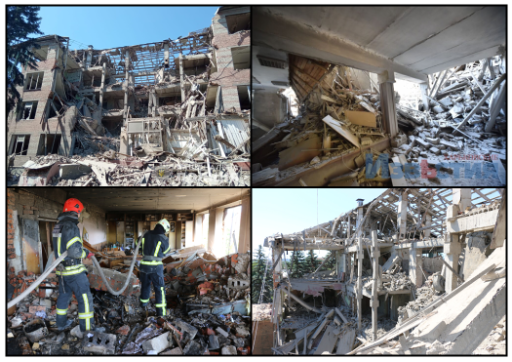
Figure 19: Images of the destruction caused by Russian missiles on a Kharkiv vocational college on June 21 [50.008740, 36.278685].
According to a report by the Kharkiv Police official page, there were no casualties as a result of the attack as the building was empty.
Volodymyr Tymoshko, the head of the Kharkiv police station who went to the scene in the morning confirmed that there were no military personnel inside the educational institution.
A video, uploaded by the Kharkiv Police YouTube channel, provides further evidence of the almost complete destruction of the educational facility. According to the head of the Kharkiv police “the attack was aimed at intimidating the population.”
Shelling Damage to Universities
In the six months between February and July 2022 Eyes on Russia documented and verified the shelling of nine university buildings in the city of Kharkiv.
The Kharkiv National University, founded in 1804 and one of the oldest universities in Eastern Europe, suffered several attacks on its many departments and institutes.
On February 25, the second day of the Russian military invasion, the University announced on their official Facebook Page that the building of the Institute of Physics and Technology had been damaged by shelling and several offices burned.
According to an article written by Dr Igor Girka, the Director of the Physics and Technology Institute, “the rockets hit the laboratory of fluorescence spectroscopy of the Department of Medical Physics and Biomedical Nanotechnology”. Dr Girka added that the shelling destroyed all the modern scientific equipment that had recently been purchased for the department.
On March 12 several photos were shared on Telegram showing the results of a new attack on the institute. Below are several images of the facade of the building showing how it looked before the damage (left), after the first shelling in February (middle), and after the second direct strike in March (right).
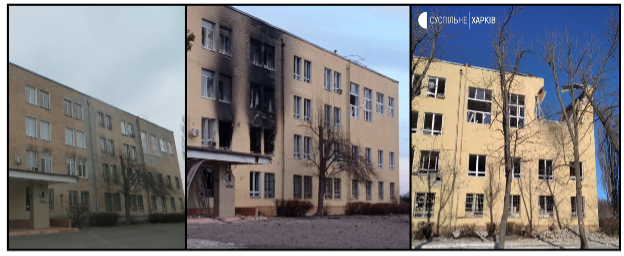
Figure 20: Images showing the Physics and Technology Institute before the Russian invasion, in April 2021 (left), after the first shelling on February 25 (middle), and after the second shelling on March 12 (right) [50.094437, 36.262731].
Multiple photos shared on Telegram provide further evidence of the extent of the structural damage and financial loss suffered by the Institute of Physics and Technology at the Kharkiv National University.
Several areas were destroyed, amongst them a lecture hall, as well as a laboratory containing technical equipment, as seen in the photos below.
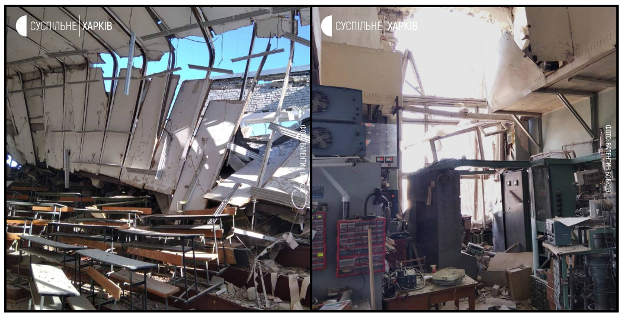
Figure 21: Images showing the damage inside the Physics and Technology Institute where a lecture hall (left), and a laboratory (right) were damaged [50.094163, 36.262247].
On March 3, Tetyana Kaganovska, the Kharkiv National University principal, shared on her Facebook page images of the damage to the Central Scientific Library of the Kharkiv National University due to Russian shelling.
According to Ms Kaganovska, “the library that has been preserved for hundreds of years [and] that was saved during World War II is now under attack”. The images shared by the principal provide evidence of the damage caused to the inside of the building and to the book collection.
The Library, which in 2013 received the status of Ukrainian national heritage, contains a large collection of ancient books and documents, some even predating the XVI century.
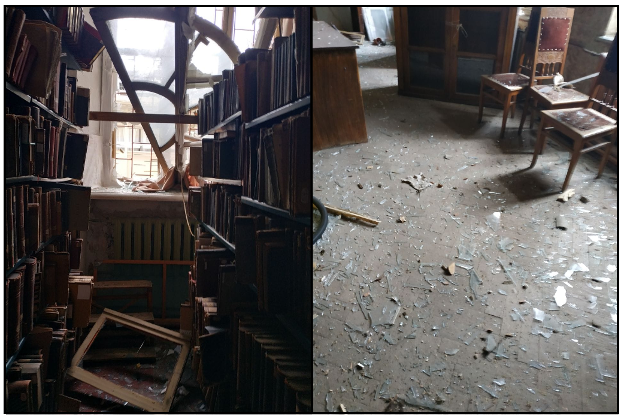
Figure 22: Images showing the result of the Russian shelling on the Central Scientific Library, on March 3 [50.004641, 36.227709].
On March 6, the Kharkiv National University shared a video on their Facebook Page showing a number of their buildings which had suffered damage at the hands of the Russian forces in the first 10 days of war.
The list contained not only educational facilities but also student dormitories, a sports complex, a museum, and the scientific library.
Tetyana Kaganovska shared on her Facebook page a video of several university students taking shelter underground as, according to the narration of the video, the Russian forces “destroy the university”. In the footage, shared on March 16, the narrator adds that four student dormitories were critically damaged by the enemy shelling, two more since the last report 10 days earlier.
On March 25, Anton Gerashchenko – the adviser to the head of the Ukrainian Ministry of Internal Affairs – published photos on his official Telegram channel showing the state of the Faculty of Economics after a Russian military strike.
The building, built in 1933 and also part of the Kharkiv National University, suffered severe damage both inside and outside as seen in the photos below.
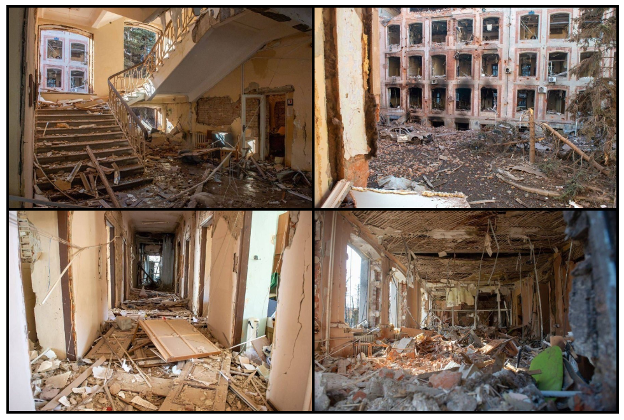
Figure 23: Photos showcasing the almost complete destruction of the Faculty of Economics of the Kharkiv National University after Russian shelling on March 24 [49.999483, 36.235620].
However, it was not only the university’s educational buildings that were shelled; the Russian military also targeted leisure facilities belonging to the Kharkiv Polytechnic Institute.
A video published by “Kharkiv News” on June 24 provides ample evidence of the direct targeting of the Sports Complex Polytechnic. According to an article by the news company, the sports complex was hit by two rockets on June 24 which caused a fire in addition to the structural damage.
The building, erected between 1985 and 1991, was an Olympic training base for the national team and contained a multitude of facilities including two swimming pools, gymnastics hall and gym.
Below are a few of the images shared on social media and within news articles that show the aftermath of the shelling on the Sports Complex in the evening of June 24.
According to the Kharkiv Polytechnic website, the full force of the missile’s impact hit the athletics arena and game hall, however the rest of the Sports Complex, including the swimming pool, also suffered considerable damage by the blast.
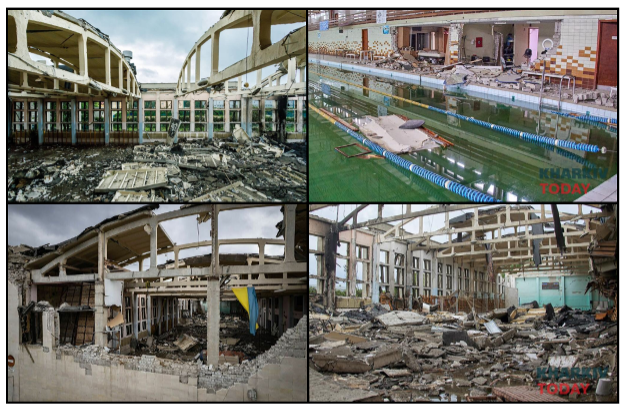
Figure 24: Images showing the destruction of the Sports Complex Polytechnic after Russian shelling on June 24 [50.009378, 36.248076].
The Sports Complex, which until recently, provided training facilities “where Olympic Games prize winners, world, European and Ukrainian champions trained”, leading to a variety of university students winning Olympic and World Cup medals, will require a large amount of financial support if it is to be restored, hindering the progress of aspiring athletes and students.
Many of the students that stayed behind were forced to look for alternatives in order to continue their education.
On May 17, the Associate Press YouTube channel published a video showing the reality of many young pupils living underground, and the efforts of teachers and lecturers in delivering educational content in a city ravaged by war.
In the footage, Mykhailo Spodarets – an associate professor at the Kharkiv National University – can be seen retreating to his basement where he delivers online lessons in Post Modern Ukrainian literature when the city is under attack.
Overall the Russian shelling targeting higher educational buildings in the city of Kharkiv not only damaged educational facilities such as lecture halls, but also destroyed technical equipment, jeopardised the safety of the young adults by targeting dormitories, and denied the access of future students to academic material and opportunities to develop skills and competencies.
Conclusion
Kharkiv, the second largest Ukrainian city, has been under almost permanent shelling since the beginning of the Russian invasion.
Between February 24 and the end of July 2022, EoR collected, verified and geolocated data on both the overall civilian infrastructure damage at the hands of the invading force, as well as the specific targeting of educational facilities in the city.
It has been possible to establish that, in certain districts, there was a clear targeting of school properties and playgrounds, as no other civilian infrastructure was damaged within a wide radius.
Although it is not possible, at present, to identify the specific Russian military vehicles from which the missiles were fired, evidence suggests that they would have been located in the Belgorod region of Russia, just North of the Ukrainian border.
In a report published in May, EoR investigators previously verified firing positions in this region for several incidents which occurred in February, leading to the damage of civilian infrastructure in Kharkiv.
Over the six months since Russia’s invasion of Ukraine, Russian shelling of various educational institutions in Kharkiv, affected more than just the structural integrity of the buildings.
Thousands of students across Kharkiv are currently deprived of a safe access to education, technical and specialised equipment and vocational training, with no end in sight as the Russian military continue their unwavering attack on the city.
An uncertain future lies ahead for the students as the new academic year draws closer.

